Thursday, March 19th 2015

AMD Announces FreeSync, Promises Fluid Displays More Affordable than G-SYNC
AMD today officially announced FreeSync, an open-standard technology that makes video and games look more fluid on PC monitors, with fluctuating frame-rates. A logical next-step to V-Sync, and analogous in function to NVIDIA's proprietary G-SYNC technology, FreeSync is a dynamic display refresh-rate technology that lets monitors sync their refresh-rate to the frame-rate the GPU is able to put out, resulting in a fluid display output.
FreeSync is an evolution of V-Sync, a feature that syncs the frame-rate of the GPU to the display's refresh-rate, to prevent "frame tearing," when the frame-rate is higher than refresh-rate; but it is known to cause input-lag and stutter when the GPU is not able to keep up with refresh-rate. FreeSync works on both ends of the cable, keeping refresh-rate and frame-rates in sync, to fight both page-tearing and input-lag.What makes FreeSync different from NVIDIA G-SYNC is that it's a specialization of a VESA-standard feature by AMD, which is slated to be a part of the DisplayPort feature-set, and advanced by DisplayPort 1.2a standard, featured currently only on AMD Radeon GPUs, and Intel's upcoming "Broadwell" integrated graphics. Unlike G-SYNC, FreeSync does not require any proprietary hardware, and comes with no licensing fees. When monitor manufacturers support DP 1.2a, they don't get to pay a dime to AMD. There's no special hardware involved in supporting FreeSync, either, just support for the open-standard and royalty-free DP 1.2a.AMD announced that no less than 12 monitors from major display manufacturers are already announced or being announced shortly, with support for FreeSync. A typical 27-inch display with TN-film panel, 40-144 Hz refresh-rate range, and WQHD (2560 x 1440 pixels) resolution, such as the Acer XG270HU, should cost US $499. You also have Ultra-Wide 2K (2560 x 1080 pixels) 34-inch and 29-inch monitors, such as the LG xUM67 series, start at $599. These displays offer refresh-rates of up to 75 Hz. Samsung is leading the 4K Ultra HD pack for FreeSync, with the UE590 series 24-inch and 28-inch, and UE850 series 24-inch, 28-inch, and 32-inch Ultra HD (3840 x 2160 pixels) monitors, offering refresh-rates of up to 60 Hz. ViewSonic is offering a full-HD (1920 x 1080 pixels) 27-incher, the VX2701mh, with refresh-rates of up to 144 Hz. On the GPU-end, FreeSync is currently supported on Radeon R9 290 series (R9 290, R9 290X, R9 295X2), R9 285, R7 260X, R7 260, and AMD "Kaveri" APUs. Intel's Core M processors should, in theory, support FreeSync, as its integrated graphics supports DisplayPort 1.2a.On the performance side of things, AMD claims that FreeSync has lesser performance penalty compared to NVIDIA G-SYNC, and has more performance consistency. The company put out a few of its own benchmarks to make that claim.For AMD GPUs, the company will add support for FreeSync with the upcoming Catalyst 15.3 drivers.
FreeSync is an evolution of V-Sync, a feature that syncs the frame-rate of the GPU to the display's refresh-rate, to prevent "frame tearing," when the frame-rate is higher than refresh-rate; but it is known to cause input-lag and stutter when the GPU is not able to keep up with refresh-rate. FreeSync works on both ends of the cable, keeping refresh-rate and frame-rates in sync, to fight both page-tearing and input-lag.What makes FreeSync different from NVIDIA G-SYNC is that it's a specialization of a VESA-standard feature by AMD, which is slated to be a part of the DisplayPort feature-set, and advanced by DisplayPort 1.2a standard, featured currently only on AMD Radeon GPUs, and Intel's upcoming "Broadwell" integrated graphics. Unlike G-SYNC, FreeSync does not require any proprietary hardware, and comes with no licensing fees. When monitor manufacturers support DP 1.2a, they don't get to pay a dime to AMD. There's no special hardware involved in supporting FreeSync, either, just support for the open-standard and royalty-free DP 1.2a.AMD announced that no less than 12 monitors from major display manufacturers are already announced or being announced shortly, with support for FreeSync. A typical 27-inch display with TN-film panel, 40-144 Hz refresh-rate range, and WQHD (2560 x 1440 pixels) resolution, such as the Acer XG270HU, should cost US $499. You also have Ultra-Wide 2K (2560 x 1080 pixels) 34-inch and 29-inch monitors, such as the LG xUM67 series, start at $599. These displays offer refresh-rates of up to 75 Hz. Samsung is leading the 4K Ultra HD pack for FreeSync, with the UE590 series 24-inch and 28-inch, and UE850 series 24-inch, 28-inch, and 32-inch Ultra HD (3840 x 2160 pixels) monitors, offering refresh-rates of up to 60 Hz. ViewSonic is offering a full-HD (1920 x 1080 pixels) 27-incher, the VX2701mh, with refresh-rates of up to 144 Hz. On the GPU-end, FreeSync is currently supported on Radeon R9 290 series (R9 290, R9 290X, R9 295X2), R9 285, R7 260X, R7 260, and AMD "Kaveri" APUs. Intel's Core M processors should, in theory, support FreeSync, as its integrated graphics supports DisplayPort 1.2a.On the performance side of things, AMD claims that FreeSync has lesser performance penalty compared to NVIDIA G-SYNC, and has more performance consistency. The company put out a few of its own benchmarks to make that claim.For AMD GPUs, the company will add support for FreeSync with the upcoming Catalyst 15.3 drivers.
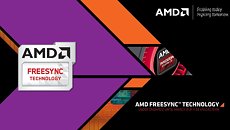

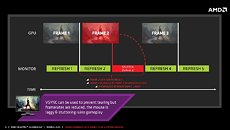
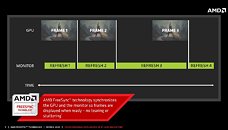
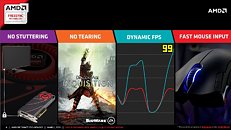

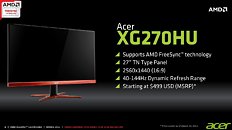
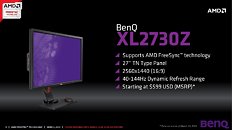
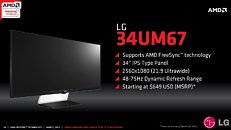
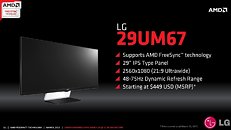
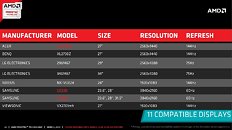
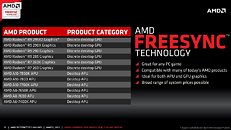
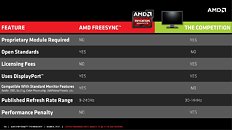
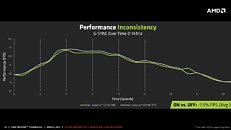
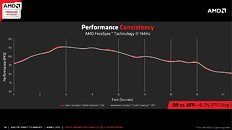
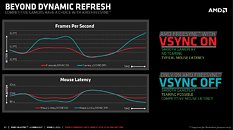
96 Comments on AMD Announces FreeSync, Promises Fluid Displays More Affordable than G-SYNC
As far as software goes Nvidia just has to change the way it communicates through DisplayPort, change the method in which it syncs. Nothing stopping them.
I am interested in seeing it in action in the real world as I want some comparisons so we can choose.
I have to say though, these advancements (Gsync and freesync) have one major purpose and that to me when the FPS is constantly changing. Situations like that mostly arise on 144hz displays whether it be 1440p or 1080p so I personally do not see much of a point on a 60hz panel even at 4K with how difficult it is to run. That being said, I will be interested in the pricing of a panel that will be 4K 60hz just for fun but I am more wanting to compare these since no matter what you choose its probably going to lock you to one side of the GPU market.
You sound like you want AMD to start making Adaptive-Sync drivers for everyone.
- Amd is NOT charging any manufacturers a licensing fee or charging royalties, so YES it is free.
- Amd has NOT locked free-sync (which I think could just as easily be called adaptive sync) to JUST AMD. I am sorry if your Nvidia cards don't support it, but you should look at your green gods Nvidia, and throw the negativity their way. Nvidia chose to not implement display port 1.2a. Can't blame AMD for that.
- Amd is not charging any markup on monitors that have adaptive-sync/free sync. That doesn't even make sense (since when does AMD make monitors)? It's very easy, Manufactures can double dip. As long as Nvidia fans buy g-sync monitors, they can keep the price high. Now that AMD has free-sync (or just call it VESA adaptive sync, and take AMD's name out all together) they are lowering the cost of basically the same panel by $100. Sure, why not? If I could sell something to you that is $100 cheaper than the competition, put back an extra $100 in my pocket, I would do the same. That basic supply/demand without drowning out the inventory of g-sync monitors.
I appreciated you chiming in with an nvidia slanted response to basically everyone's post is every AMD thread ever, but I had to correct just these few pieces for you.
Nothing has to be certified for it to work. That's a formality for branding b/c people are stupid and have no idea what adaptive sync is.
If you buy Nvidia currently, you probably don't mind paying a bit more for G-Sync - after all it is cheaper than buying a new AMD GPU and Free-Sync monitor. If you have a GCN 1.1(?) gpu now, it's great for you as well.
There's no needs for folks to get all antsy about it and leap to either sides defence.
I just like the thought that no matter what camp your in (green or red or intel) , we can all benefit from baby smooth frame rate gaming. That's what it should all be really be about.
support.amd.com/en-us/search/faq/214 <--you are not one of them that gets it i see.i guess that goes without saying amd fans that flame and troll nvidia threads. Sad all people that bite on every word AMD claims even if they are not true. I guess 75% of market share that uses nvidia shows how well those lies are working out for AMD.Only works with AMD cards as its proprietary use of the spec. its option part of DP 1.2a not required so. not anything with 1.2a will support it.
/me clicks unwatch on this thread to not see idiot response email updates.
I recently had to ignore a chappy like this from the red camp. This must be his green brother. I literally don't know what he's saying.
titter titter tee hee
/looks around for his "twin" :roll:
:p
We are getting there, we are starting to see IPS technology creep into the 120+hz range (on the mainstream, yes I know korean overclocking panels have been around) This is good for everyone, so for Free-sync (adaptive sync) nothing would change just the hardware being released from the panel manf's. Then for G-Sync, a potential update to the G-Sync module broadening its range (which would of course be installed on whatever new panel technology comes out) as you wont be able to update your existing monitors g-sync module to support ranges outside of what the integrated panel can support. Either way a new monitor would be required......
Just wanted to add that.
I think the devil in the details will be those monitors that have not gone through the AMD certification program, BUT offer adaptive sync MAY give users a sub-par experience which people might confuse and throw back at AMD, calling it free-sync. Free-Sync monitors are only monitors that AMD has sanctioned to perform within AMD spec and offer AMD's sough after experience in the adaptive sync realm. This is where I think we might see a fork in the road.....
Keep in mind a "Free-Sync" experience will involve a driver portion from AMD, so they do have skin in the game. This is why they also have the cert program to make sure it's all correct. Now running a intel broadwell with a normal adaptive sync monitor, that's not AMD anymore.
I am just glad we have finally rid the issues of v-sync vs input vs tearing across the board. (Or at least are working towards there)